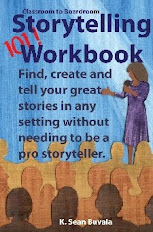I am spending some more time in the hard-core storytelling practitioner mode. My next thought: There are two ways to describe the pacing of your story.
First, pacing refers to how fast your story unfolds. Do you spend more time on some parts of the story and less time on other parts? You may want to spend more time on one episode, piece or interaction in your story than another. Your audience will help you determine this. Although you may be telling the same story, the differences in your audience will help you to know when to focus more on part A or part B.
For example, when I tell my version of the "Fisherman and His Wife" to children, I will spend more time on the "funny" parts of the tale such as the fisherman and the fish speak to each other as well as the characteristics of how the wife reacts to each new change. When I tell the story to adult audiences, I will spend more time with the relationship between the fisherman and his wife. Since my stories are in episodes rather than a script, it is easy for me to change the pace at which each segment is revealed.
There is a second way to describe pacing in storytelling. How fast you speak while telling the story? Mastering intentional pacing can help you create nuances in your story.
When you speak with a slower pace, you might be conveying the ideas of fear, anger, disbelief, astonishment, or awe.
When you speak very quickly you may also be sharing the emotions of fear, anger, excitement, energy, joy, surprise.
You will notice that I listed the words fear and anger for both slow and quick pacing. Think about the following questions. What (or WHO) makes the difference in how those emotions are conveyed? Does it make a difference in who is being addressed? Does it make a difference in where the action is taking place?
Overall, most new tellers don't think about the ideas of pacing. They simply tell their story, with their pacing based on whether they are having trouble remembering the episodes (slow pacing) or just trying to get all the words out of their brain (fast pacing).
Rather than just let your words fall randomly from your mouth, make intentional choices about how fast your characters speak
******
Sean Buvala is a storytelling coach and practitioner. He's the creator of the Storytelling 101 Elearning kit.
Subscribe to:
Post Comments (Atom)






That's a great piece Sean. I had an experiences with the second way of pacing just not long ago, when visiting the US. In Hebrew I can play around with pace with great ease. In English - well that's a different story. Yet after a couple of days in an English speaking environment, feeling rather clumsy about language and pace, I noticed I restored pace. It was just different than the pace I'm used to.
ReplyDeleteIt gave me a new point of view about the use of pace and language. I eased into the slower pace and it enriched my expression. The stories were different, not only delivered slower. I had to fill-up the spaces, and not necessarily with more text. It felt like riding a slow wave - with more power from the inside and enough time to let utterance become elaborate vocally.
It was a unique experience, and your words helped me recognize and frame it more clearly.
Thanks.